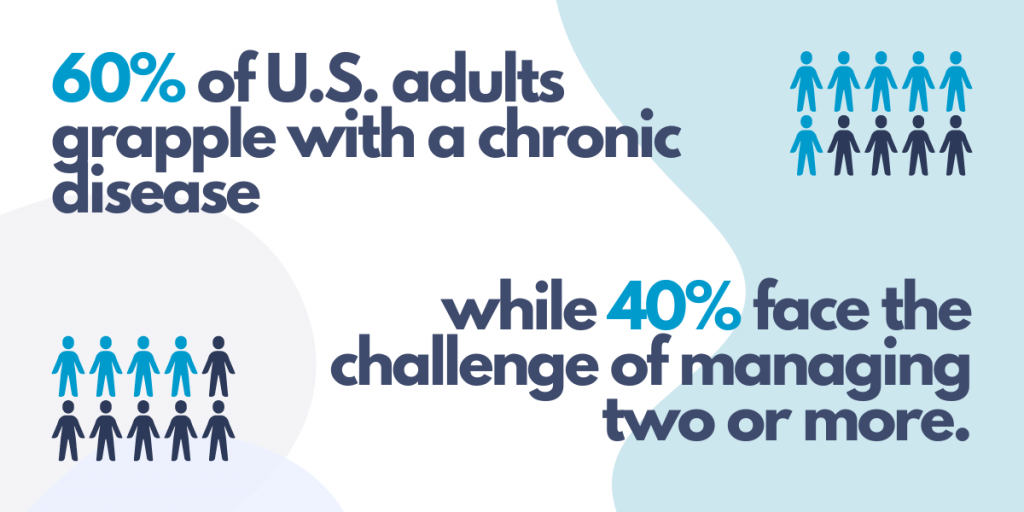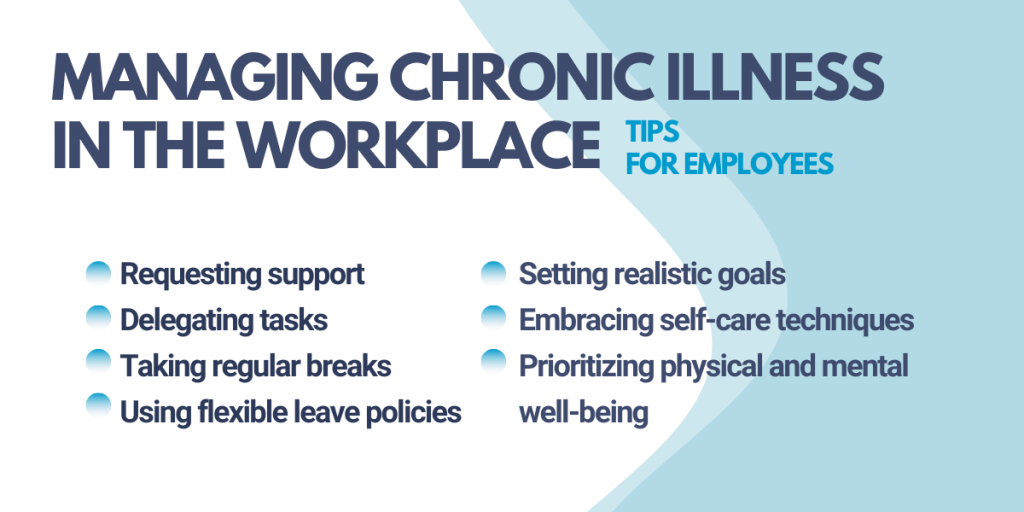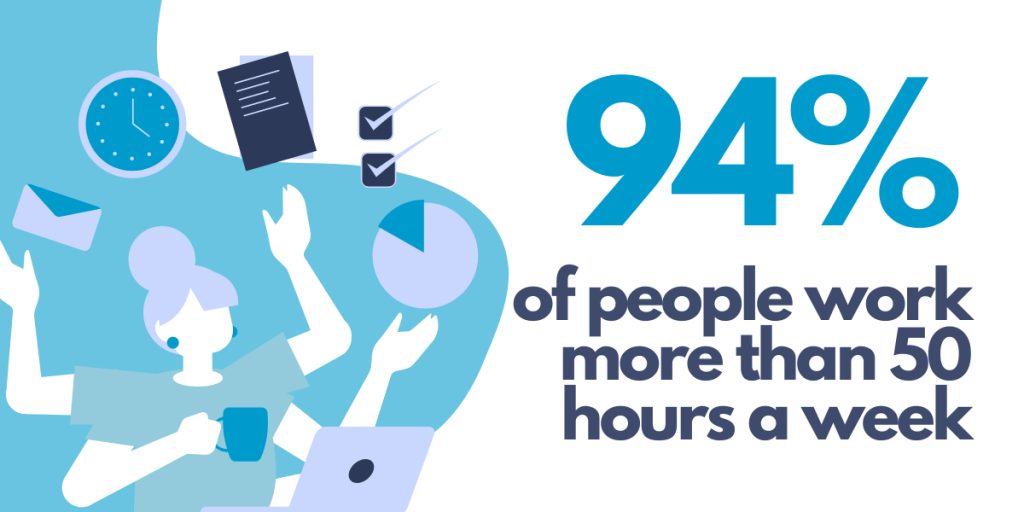
60+ Nutrition Statistics
From the prevalence of obesity to sodium intake and children’s nutrition -explore over 60 nutrition statistics, shedding light on the impact of dietary habits on health and well-being.

The definition of chronic disease shifts almost every decade, but the underlying premise remains the same: if the condition affects a person for a more extended period and causes issues in their day-to-day life, it’s chronic. In fact, the CDC has elegantly classified it like this: “conditions that last one year or more and require ongoing medical attention or limit activities of daily living or both.”
Making it abundantly clear that people who suffer from chronic conditions will face the same symptoms at the workplace as much as they do at home. And chronic diseases in the U.S. continue to surge, making them some of the nation’s most widespread and expensive health concerns.
From diabetes to arthritis, heart disease to mental health disorders, these conditions affect a significant portion of the workforce, thus shaping the healthcare benefits landscape for employers.
Beyond legal compliance, accommodating chronic illness in the workplace has become a strategic tool for companies to control costs and improve employee well-being.
The logic is that through early intervention and effective health management employees with chronic conditions can become healthier and more productive.
In this Shortlister article, we delve into chronic illnesses, exploring their prevalence and impact on the workplace.
According to the Centers for Disease Control and Prevention (CDC), 60% of U.S. adults grapple with a chronic disease, while 40% face the challenge of managing two or more. These statistics underscore the substantial impact long-term conditions have on the nation’s annual healthcare spending, which amounts to a staggering $4.1 trillion.
The burden of chronic illnesses extends not only to individuals but also to employers and the economy at large.
Before we explore possible solutions to alleviate the consequences, let us first understand the underlying reasons why.
Broadly defined, chronic illness it’s a long-term health condition that persists for an extended period, and it may result from various factors, including genetics, lifestyle, or environmental influences, and often requires ongoing medical management that can impact a person’s daily life and overall well-being.
Common examples include diabetes, arthritis, heart disease, asthma, and chronic obstructive pulmonary disease (COPD). Mental health conditions such as depression, anxiety disorders, bipolar disorder, and schizophrenia also fall under chronic illnesses.
Seeing how widespread they are, their impact is not limited to personal lives.
Working adults with chronic illnesses often face challenges affecting their productivity, job performance, and overall job satisfaction.
For example, fatigue, pain, cognitive difficulties, and emotional challenges may hinder job performance, raising the issue of dealing with chronic illness in the workplace.
Taking the initiative to comprehend chronic illnesses is a crucial starting point. This understanding lays the foundation for fostering empathy and providing much-needed support within the workplace, ultimately empowering employees to thrive despite their health challenges.

A Commentary on Chronic Disease Prevention in 2022 by the NACDD reveals that treating the seven most prevalent chronic diseases (heart disease, cancer, chronic lung disease, stroke, Alzheimer’s disease, diabetes, and chronic kidney disease) and their associated productivity losses are projected to impose an annual cost of $2 trillion on the U.S. economy by 2030.
This amounts to approximately $8,600 per person.
However, the study also suggests that positive changes to unhealthy behaviors could save an impressive 1,100,000 lives each year.
These projections underscore the importance of addressing chronic illnesses in the workplace.
Moreover, the responsibility to recognize and ease these challenges in the work environment falls on employers, managers, and HR professionals.
Chronic illness patients may encounter unique obstacles that impact their work performance and overall well-being. For example, fluctuating health conditions, medical appointments, and the need for rest can challenge traditional work expectations. Thus, the organization’s understanding of these barriers is essential in offering appropriate support and reasonable accommodations.
One of the cornerstones of effectively dealing with a chronic condition is fostering open communication and empathy. Encouraging a culture where workers feel comfortable discussing their health challenges allows for early intervention and appropriate support.
With that in mind, companies can facilitate workshops or training sessions to promote awareness and understanding of chronic illnesses among all employees, including leadership.
However, this is merely scratching the surface of dealing with chronic illness in the workplace.
According to the NACDD report, many chronic diseases, complications, and related costs are preventable. Early detection programs in public health have successfully identified thousands of breast and cervical cancers in their early stages, leading to more effective and less expensive treatments.
Therefore, providing the right resources, accommodation, and support systems is vital in helping employees cope with their chronic illnesses or bypass them altogether.
Some of the ways employers can support a healthier lifestyle and remove barriers for workers to receive preventative care are:
Addressing chronic illnesses is both an economic necessity and an ethical responsibility for employers.
By prioritizing open communication, empathy, and the right resources, they can create a supportive work environment that empowers their entire workforce.
While creating a safe and supportive workplace is a shared responsibility between employers, HR, and management, employees with a chronic condition diagnosis have a responsibility to ensure their well-being and success.
For one, they can and should confidently utilize their rights to reasonable accommodation.
Before doing that, however, they must understand their limitations, be it reduced mobility, emotional distress, or their dependence on medication, and communicate this effectively with employers and colleagues.
An open dialogue about health conditions fosters a supportive work environment, making it easier to manage workloads while accommodating necessary health-related requirements.
Another way is to strike a balance between their work and health needs.
Employees can use different strategies to manage chronic illness in the workplace, such as:
Prioritizing health is essential to prevent burnout.
Therefore, workers could schedule regular doctors appointments, adhere to prescribed treatments, and engage in healthy lifestyle practices to manage their chronic conditions effectively.
By integrating self-care strategies into their daily routines, such as mindfulness exercises, proper nutrition, and adequate sleep, employees can enhance their resilience and cope better.
Ultimately, it is crucial to remember that everyone has the right to thrive in the workplace, even with a chronic illness.
Employees can pave the way for a more inclusive and supportive work environment that allows them to achieve their full potential by staying vocal about their rights, embracing healthy and balanced practices, and advocating for reasonable accommodations.

While discussing how employers and employees can manage chronic conditions, we briefly touched on the case of reasonable accommodation. But let’s take a step back to understand the broader implications.
More than half of the adult population suffers from a long-term illness.
Even more concerningly, we’ve seen that millions of people live with two or more conditions that can significantly affect their employment.
As businesses strive to foster a culture of diversity and inclusivity, including this significant and often overlooked segment of the workforce becomes increasingly important. While chronic illness remains an invisible barrier for many employees, acknowledging and accommodating this diverse group is paramount to promoting a truly inclusive workplace.
In that sense, accommodation refers to making reasonable adjustments to support workers with chronic illnesses while ensuring they can perform their duties effectively without discrimination.
These adjustments may involve modifying the work environment, tasks, or workday structure. The goal is to create a level playing field, providing all employees equal opportunities for success and growth, regardless of their health challenges.
However, it’s crucial to understand that these accommodations are not one-size-fits-all solutions. Instead, they should be tailored to meet the unique needs of everyone.
For instance, employees with diabetes could benefit from flexible meal breaks and access to healthy snacks to manage their blood sugar levels effectively.
People with heart disease may benefit from a workplace that promotes a heart-healthy lifestyle, such as on-site fitness classes or designated walking areas and stress management. Meanwhile, workers dealing with depression or anxiety may find relief through flexible work hours and access to a quiet workspace.
Seeing how employees’ health conditions may fluctuate, recognizing that everyone’s needs and challenges are unique is necessary to provide appropriate accommodation.
Ultimately, as more organizations prioritize this matter and openly discuss chronic illnesses, it helps break down barriers and misconceptions.
Chronic illnesses can cast a long shadow on the lives of those affected.
Beyond the physical challenges of living with one, people diagnosed with a long-term disease must also bear the weight of societal stigma.
From ignorance and avoidance to hiring discrimination and reduced opportunities, ableism hinders the workplace as much as it does in other aspects of their lives. But the notion that these individuals are vulnerable, unreliable, or that they exaggerate their symptoms is stereotypical and harmful.
In fact, one study sheds light on the significant role of anticipated stigma, which involves the fear of future prejudice and discrimination directed at chronic illness patients, and how it profoundly influences their well-being.
The analysis revealed that stigma from different sources, including friends, family, work colleagues, and healthcare workers, was interconnected and deeply impacted participants’ stress levels, social support, patient satisfaction, and overall quality of life.
Namely, the consequences of higher stress levels and reduced social support significantly lowered their quality of life.
These findings underscore the importance of addressing misconceptions surrounding chronic illnesses in the workplace and promoting understanding among colleagues.
Encouraging open dialogue and fostering a culture of empathy is vital.
Employers and HR professionals can initiate educational initiatives to dispel myths and stereotypes about these conditions. Moreover, by creating a safe space for employees to discuss their health needs and challenges, colleagues can develop greater empathy and offer meaningful support.
Providing accurate information in the fight against chronic illness stigma helps create a more empathetic and informed workforce. One that sees people with disabilities as complete individuals rather than a collection of their symptoms.
Combating deeply rooted stereotypes and prejudice is easier said than done.
Despite efforts to promote understanding and empathy, some individuals may still harbor discriminatory attitudes toward people with chronic illnesses, so organizations must be aware of their employees’ legal rights and protections.
In many countries, laws exist to safeguard people with disabilities, including those with chronic illnesses, from discrimination in the workplace.
For instance, the Americans with Disabilities Act (ADA) in the United States, the Equality Act in the United Kingdom, and similar legislation in other countries prohibit discrimination based on disability, including chronic health conditions. These laws typically require companies to provide reasonable accommodations to workers with disabilities to enable them to perform their jobs effectively.
Compliance with and understanding the ADA’s provisions is essential to creating an inclusive work environment.
HR professionals should be well-versed in them, guiding employees and employers through accommodation requests and enabling a fair and accessible workplace.
To better comprehend the ADA’s implications, employers and employees can rely on authoritative government and legal resources, such as the U.S. Equal Employment Opportunity Commission (EEOC), where comprehensive information, guidelines, and real-life case studies provide valuable insights for in-depth analysis.
While these lay the foundation of fair treatment and a supportive work environment, other rights, and legal considerations include:
Overall, awareness and adherence to legal protections prevent discrimination and empower employees to achieve a healthier work-life balance.
Striking a work-life balance in a fast-paced work environment is challenging enough, let alone with a chronic illness.
A survey by Harvard Business School revealed that 94% of people work more than 50 hours a week. However, such long working hours can lead to burnout, taking a toll on employees’ health and personal lives.
The challenges for individuals managing chronic illnesses are further exacerbated by fatigue, reduced energy, frequent medical appointments, flare-ups, and even stigma.
Recently, remote work and flexible arrangements have emerged as game-changers, particularly for workers struggling with their health. By allowing them to work from home or adopt flexible schedules, employers enable employees to structure their work in a way that best suits their health requirements.
In fact, remote work statistics show that for 77% of respondents, this would help better manage their work-life balance.
Beyond flexible work, optimizing employee performance while accommodating their health needs can take the form of task prioritization, workload management, access to health and wellness programs, and support groups and counseling services.
All these contribute to a better work-life balance, supporting the health, wellness, and productivity of employees with long-term illnesses.

Accommodating employees with chronic illness in the workplace requires a multifaceted approach on all organizational levels, especially in the context of remote work and flexible arrangements.
It’s not solely the responsibility of the employer or HR to ensure a supportive work environment for their employees, but it’s also managers and co-workers.
Therefore, educating and enabling training programs tailored to managing employees with chronic conditions equips managers with the necessary knowledge and skills.
These initiatives should focus on cultivating empathy and understanding among managers, which then transcends into the work environment among all employees.
Emphasizing ongoing communication and support between managers and their employees is key. This includes regular check-ins and open discussions about potential accommodation or challenges that allow managers to stay informed about their team members’ needs and well-being.
A supportive, understanding, and educated managerial approach contributes to a positive work culture, benefiting the entire workforce.
As we wrap up this article, let’s explore some inspiring real-life examples of how companies can successfully accommodate their employees’ needs.
One valuable resource for such accommodations is the Job Accommodation Network (JAN), which operates under the U.S. Department of Labor.
JAN aims to assist individuals with disabilities and their employers in navigating workplace accommodations effectively, resulting in many success stories that demonstrate the positive impact of thoughtful accommodations.
For example, an employee with ADHD-induced time management issues working as a delivery person was provided a personal organizer watch with auditory and written prompts to help her move quicker from task to task.
Similarly, a switchboard operator coping with chronic pain found resolution through accommodations that included flexible scheduling, designated rest breaks, and an adjustable workstation. The ability to alternate between sitting and standing significantly alleviated the employee’s condition.
In another case, an engineer with Parkinson’s disease facing difficulties with concentration and communication was accommodated with a quiet, distraction-free office and a communication device.
These are a few of the many stories that underscore the significance of tailoring accommodations to meet individual needs, fostering a more inclusive and supportive work environment for all employees.
Ultimately, by embracing such practices, companies can genuinely empower their workforce and promote a culture of compassion and understanding.
Supporting employees with chronic illness in the workplace is a legal obligation, but even more so, a demonstration of empathy and care.
Understanding the condition, breaking down stereotypes, and providing proper accommodation allows companies to recognize their employees’ strengths, talents, and unique qualities beyond their medical needs.
It empowers individuals with disabilities to assert their autonomy and participate fully in all aspects of life while building a healthier and more supportive work environment for everyone.
Content Writer at Shortlister
Browse our curated list of vendors to find the best solution for your needs.
Subscribe to our newsletter for the latest trends, expert tips, and workplace insights!

From the prevalence of obesity to sodium intake and children’s nutrition -explore over 60 nutrition statistics, shedding light on the impact of dietary habits on health and well-being.

Explore the difference between group insurance and blanket health policies to help you choose the right insurance plan for your organization.

Caregiving comes with emotional and financial challenges. Alaina Melena of Family First shares practical tips to manage costs while keeping your family’s well-being front and center. Learn how to budget wisely, access resources, and provide compassionate care without sacrificing financial security.

Explore the connection between stress and heart disease. Dive into the role of stress management and cardiovascular health programs in preventing coronary conditions.
Used by most of the top employee benefits consultants in the US, Shortlister is where you can find, research and select HR and benefits vendors for your clients.
Shortlister helps you reach your ideal prospects. Claim your free account to control your message and receive employer, consultant and health plan leads.